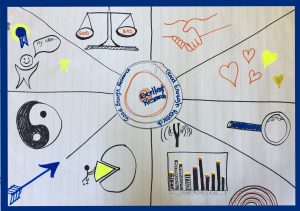Reading to Write
 Today’s reflections connect to Wednesday’s readings about the quality of qualitative research and how they connect to my own writing. It’s very difficult to judge your own work, but with the frameworks provided in the readings, it’s easier to recognize quality in the work of others. It was interesting to complete the activity in class to capture the ideas from the readings. Our group decided to create a graphic diagram to connect to the key concepts from Tracy’s (2010) article about the eight “big tent” considerations for quality qualitative research. We then put key words for those eight ideas onto sticky notes and had classmates try to match the icon with the idea. This proved to be more subjective and interpretive than we had thought, and yet the conversations opened up the other ways of knowing around these criteria that was helpful for all. The key words include worthy topic, rigor, sincerity, credibility, resonance, significant contribution, ethics, and meaningful coherence. Can you match them up? Knowing that the images were drawn in class with suggestions and ideas offered by the group, but due to limited graphic art skills, may not be as effective as they could be with some preparation.
Today’s reflections connect to Wednesday’s readings about the quality of qualitative research and how they connect to my own writing. It’s very difficult to judge your own work, but with the frameworks provided in the readings, it’s easier to recognize quality in the work of others. It was interesting to complete the activity in class to capture the ideas from the readings. Our group decided to create a graphic diagram to connect to the key concepts from Tracy’s (2010) article about the eight “big tent” considerations for quality qualitative research. We then put key words for those eight ideas onto sticky notes and had classmates try to match the icon with the idea. This proved to be more subjective and interpretive than we had thought, and yet the conversations opened up the other ways of knowing around these criteria that was helpful for all. The key words include worthy topic, rigor, sincerity, credibility, resonance, significant contribution, ethics, and meaningful coherence. Can you match them up? Knowing that the images were drawn in class with suggestions and ideas offered by the group, but due to limited graphic art skills, may not be as effective as they could be with some preparation.
This then led to a full afternoon of reading articles and research, locating and scanning articles for research, and collecting information with which to write. This was a circular, spiralling process that kept redirecting me to new digital library locations in search of new ideas. It started with a search for the original source for information to define Ubuntu, which I was able to locate. This confirmed that I could include that quote into my paper, as well as consolidate understanding on the term. But, this led to other writing by the same author which opened me to the ideas about ‘cosmopolitanism’. I’ve set those readings aside for later review.
The connections spiralled me into phenomonology and a dissertation that uses this methodology about ‘being, belonging, and becoming’. This title had key words tied to my own paper, so I had to have a look. After a brief read, and a search through the reference listing, I discovered work by Ihde (1979) titled Technics and Praxis which led me to search for this theorist and dig a little deeper. This is now incorporated into my writing as a piece that will tie in, but further reading and thinking is needed to ensure there is a fit.
Then onto searching and reading some works from Henry Jenkins about participatory cultures, reviewing articles written by James Paul Gee about affinity spaces, building some key links to Mizuko Ito and danah boyd’s work on connected learning, and then I came up for some air.
It was an exhausting process, but thrilling as well – it’s like finding hidden puzzle pieces that you didn’t know existed, but ones that you’ll possibly need to complete the 10,000 piece puzzle you’ve started putting together. You know it’s going to fit somewhere, but you’re not sure where, or even if it’s the right piece for your puzzle. It may be the piece someone else needs for their puzzle, so you give it away. I did send several pieces to others in my class, knowing that it could be that essential piece they’ll need to complete their 10,000 piece masterpiece.
So the puzzling continues tomorrow – more writing than reading I hope.
References
Tracy, S. J. (2010). Qualitative quality: Eight “big-tent” criteria for excellent qualitative research. Qualitative inquiry, 16(10), 837-851.
